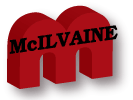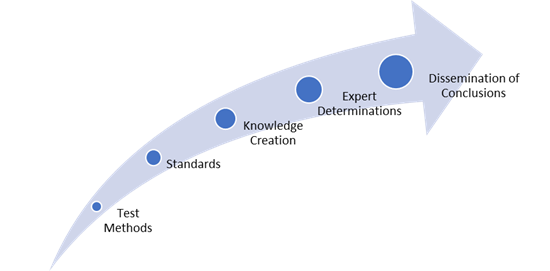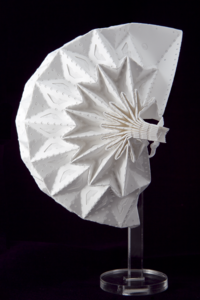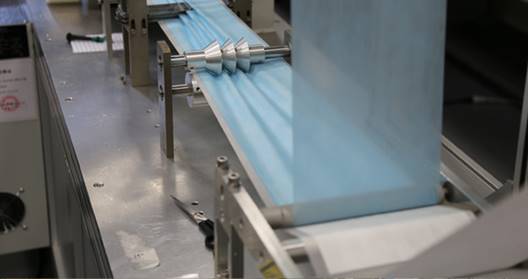
Coronavirus Mask
Decisions
February 19, 2021
Mask Decisions will be Shaped by
in a Multi-Step Process
Mask Use to Continue After the
Pandemic
Expanding the Amount of Filter
Area with
Origami Designs
ICS will have an ASTM F3502 /
Seal Mark
Premium PPE Makes 30 Million
Masks per Month
____________________________________________________________________________
Mask Decisions will be Shaped by
in a Multi-Step Process
The new ASTM standards in the
U.S. and public mask standards
in Europe are a great first step
for mask selection but need to
be incorporated into a
multi-step process. The
ultimate decisions by purchasers
are likely to be made by ratings
from magazines such as
Consumer Reports.
The magazine rates sun tan
lotions not just on the
protection factor appearing on
the bottle but with a
combination of factors which are
more reflective of the
protection.
Will a mass publication such as
Consumer Reports be able
to rate masks with similar
insight?
Earlier this month
Consumers Reports was
anticipating the ASTM standards
and raising the mask leakage as
a major concern. The takeaway is
that if mass media are presented
with the best insights their
advice to readers will be
reflective.
There are minimum safety
standards for cars. However,
safety ratings provided by the
media and experts make safety a
major purchasing factor even
though all cars meet the
minimums. Masks like cars affect
health and life. So most people
will be swayed by reliable mask
safety ratings.
The challenge for the
mask industry is to create a
dependable mask selection
process and then make sure it is
made available.
There are a number of steps in
the process.

Multi-Step Mask Selection
Process
Test Methods
ASTM and EU Public Mask
Standards are based on tests
which have widespread
acceptance. ASTM has made a
great contribution by
stipulating tried and true test
methods. The ASTM standards are
based primarily on particulate
efficiency and resistance. These
tests alone will go a long way
toward eliminating masks which
are ineffective. However, there
is still much to be done on test
methods.
1.
Particulate Efficiency:
Coronavirus is a 0.1 micron
particle generally transmitted
in a droplet. That droplet
captured on the interior of a
mask will evaporate or split. So
the initial capture is only part
of the story.
2.
Resistance: The resistance
increases by the square of the
air velocity. Two variables
needing consideration are the
amount of mask filter area and
the breath volume of the wearer.
The concern about a 5 mm H20
limit on resistance is addressed
just by adding a little more
filter area.
3. Fit: Air leakage can exceed 50% in actual conditions of wear. On the other hand custom fitted N95 masks have almost no leakage when tested initially but there is no assurance that an individual will wear it properly.
Surgical masks have large amounts of leakage but with an external brace may reduce leakage to less than 10%. Virus inhalation = particulate inefficiency plus leakage. There is a concern about a particulate efficiency reduction of a few %. That same percent of leakage is just as important.
Fit tests for the public can include use of mobile phone apps which analyze pictures. They can use other remote camera inspections by experts. Novel qualitative tests with perfume, lights, pressure etc. all need to be investigated.
4.
Quality Control:
Eurofins, SGS, Bureau Veritas,
UL, and others are active
worldwide and can provide
quality control seals based on
the ability to inspect
manufacturing
operations around the
globe.
Standards
The ASTM standards are a big
step forward but as new test
methods are developed the
standards will need to be
changed. Also there is a need
for international uniformity in
standards. The use of the
standards by government
organizations such as OSHA is
critical.
Knowledge Creation
There is a great deal of
information about masks being
generated in research papers,
magazines, supplier news
releases etc. The challenge is
to turn information into
knowledge. Associations,
conference organizers, and
publishers can all play a role.
INDA is an association which
holds relevant conferences and
publishes two magazines which
contribute to creating knowledge
on the subject.
Coronavirus Mask Decisions
includes the daily information
with some conversion to
knowledge.
Several search engines
provide an information gathering
function. Webinars further
provide the knowledge
conversion. An intelligence
system provides an organized
approach to knowledge creation.
Suppliers of masks, media,
components, and services should
bear the main responsibility for
knowledge conversion. White
papers are needed. But the
willingness to debate is also
important.
Expert Determinations
Once information has been
converted to knowledge experts
can draw meaningful conclusions.
For example in the CMD
intelligence system there are
extensive analyses and reports
commissioned by Vogmask who has
five mask sizes and is
continuing to improve mask fit.
This knowledge can be the basis
of a conclusion about the
effectiveness of Vogmask versus
a mask with fewer sizes, less
performance testing, and quality
control.
Those organizations involved
with quality control seals can
expand their role. Alternatively
consulting organizations can
provide high level comparisons.
They also have the opportunity
to make these determinations for
a complete safe bubble for which
the mask is only one component.
Dissemination of Conclusions
The suppliers, associations, and
industry media need to make sure
that the appropriate conclusions
are provided to the main stream
media and to user groups. It is
also necessary that the
appropriate conclusions be
conveyed to governmental
organizations. Consider the
power of a conclusion presented
to a city that the mask
efficiency and restaurant
occupancy rate together provide
a risk factor. So 25% occupancy
with the typical 25% effective
cloth mask provides the same
risk as a 90% effective mask and
90% occupancy.
The ASTM standards are a good
start toward a multi-step mask
selection process which will
save countless lives while
creating a huge industry.
Mask Use to Continue After the
Pandemic
Masks may become a mainstay
after the pandemic to help keep
both viruses and pollution at
bay. While masking is already
part of daily life in other
countries, that hadn’t been the
case for the United States. But
a recent National Geographic and Morning
Consult poll signaled a shifting
attitude in the U.S. toward
masking up.
Some 63 percent of 2,200
American adults said they would
continue to always or sometimes
wear a mask while running
errands post-pandemic. A similar
number, around 64 percent, said
they would turn to masks to fend
off air pollution. And 67
percent said they would mask up
during flu season.
Expanding the Amount of Filter
Area with
Origami Designs
The new ASTM standards specify
the display of the resistance of
the mask material. But this is
based on a specified velocity
through the material. The more
relevant velocity is based on
the amount breathed by an
individual and the amount of
filterable material. If the
individual has lower breath
volume or if the amount of
material is greater then the
resistance will be lower.
Richard Gordon, the founder and
CEO of Air99
LLC.
is one of a growing number of
mask designers who see the
promise of better fit, function,
and even fashion in the ancient
art of origami.

The folds of the Airgami mask
make it easier to breathe by
dramatically increasing the
amount of surface area for air
to pass through. Unfolded, the
filter is two to three times as
large as common N95s.
Finding the right material is
just the first step of crafting
an effective mask. “It doesn’t
matter how good the filter is if
you don’t have a good fit,”
says John
Volckens of
Colorado State University, who
led an intensive
testing effort to document the
filtration efficiencies for an
array of materials.
When improperly designed or
worn, masks can have gaps around
the nose or cheeks, allowing
entry and exit points for
potentially virus-laden
particles to flow—and closing
these gaps is where origami
truly shines.
Origami techniques are already
central to many masks on the
market today, Volckens notes. 3M’s
VFlex,
for example, combines folding
with heat welding to hold the
material together, creating a
more comfortable version of an
N95.
Another solution for holding a
crease is creating an outer
skeleton of stiff material.
Air99's Airgami mask, for
example, is made of a flexible
N95-grade filter fused with a
more rigid and foldable layer.
Since the outer structure
doesn't allow air to pass
through, it's punched with holes
so air can reach the filter
layer.
We need better face masks—and
origami might help (nationalgeographic.com)
ICS will have an ASTM F3502 /
Seal Mark
Mr. Dale
Pfriem, CEO of
ICS advised us yesterday
that his company will be
initiating its Seal Mark program
(traditionally used for sports
eyewear products, etc. as
respiratory devices must be
either CE or NIOSH certified) to
the new ASTM F3502 standard.
“We’ve been testing respiratory
protective devices for over 25
years so we trust our mark will
go to support the new standards
mission to convey confidence to
the market”.
ICS Laboratories is a leading
source for accredited
third-party conformity
assessment of respiratory
protective equipment. ICS tests
respirators, filters, cartridges
and their many associated
devices and accessories to a
wide range of US (NIOSH),
European (EN) and Australian
(AS/NZS) standards. Their
capabilities are extensive and
range from disposable half-mask
filtering face piece respirators
to specialized equipment
designed to protect against
chemical, biological,
radiological and nuclear
respiratory hazards (CBRN).
ICS Laboratories’ scope of
accreditation offers the most
extensive coverage of respirator
test protocols published by the
CDC of any independent
conformity assessment body. ICS
is accredited to perform over 75
NIOSH standard test procedures,
spanning the complete range of
respiratory protective devices
(FFP/N95, APR, PAPR, SAR, SCBA
and SCSR). Their test
reports are accepted by NIOSH as
pre-submittal performance data.
Pre-submittal test results are
required by NIOSH as part of
their approval process
for respiratory PPE intended to
be marketed, sold, or
distributed in the US for
occupational use.
ICS Labs’ expertise in this area
offers its clients endorsed test
reports containing reliable data
and results for globally
relevant standard test method
and performance requirements for
respiratory protection.
Premium PPE Makes 30 Million
Masks per Month
Premium-PPE in Virginia Beach
has invested $5.3 million
to expand and meet increased
demand. That also means new jobs
in the resort city. Brent Dille
is commercial director and has
years of expertise in the
filtration industry. We talked
to him today and learned that he
is moving forward to create the
American Mask Manufacturers
Association . He promised to
provide the details when the
organization launches its
website. Premium PPE has
become a significant mask
supplier.

The CEO of Premium-PPE, a
manufacturer of AmeriShield
branded masks, Vitali Servutas
says like many, they were caught
off guard with COVID-19.
He says when they tried to order
masks, they had a hard time
getting them.
“We couldn’t buy anything in the
United States. We have contacts
overseas in China and we started
importing them and it was very
difficult,” said Servutas.
That’s when one of his partners
suggested they make their own in
Virginia Beach. They were able
to find a machine and, with
their engineering background,
got to work. He says the
operation started in a small
room. Now there’s an entire
warehouse full of machines.
“We were seven employees in the
early days and now we’re over
250. So we’re adding more and
more people every week we’re
running three shifts as well,”
Servutas explained. Now, they
make 1.2 million masks per day
up from 750,000 masks a day
prior to the expansion.
More details on their operation
can be obtained from Brent Dille
at 412- 401-2134. His email is
brent@premium-ppe.com
